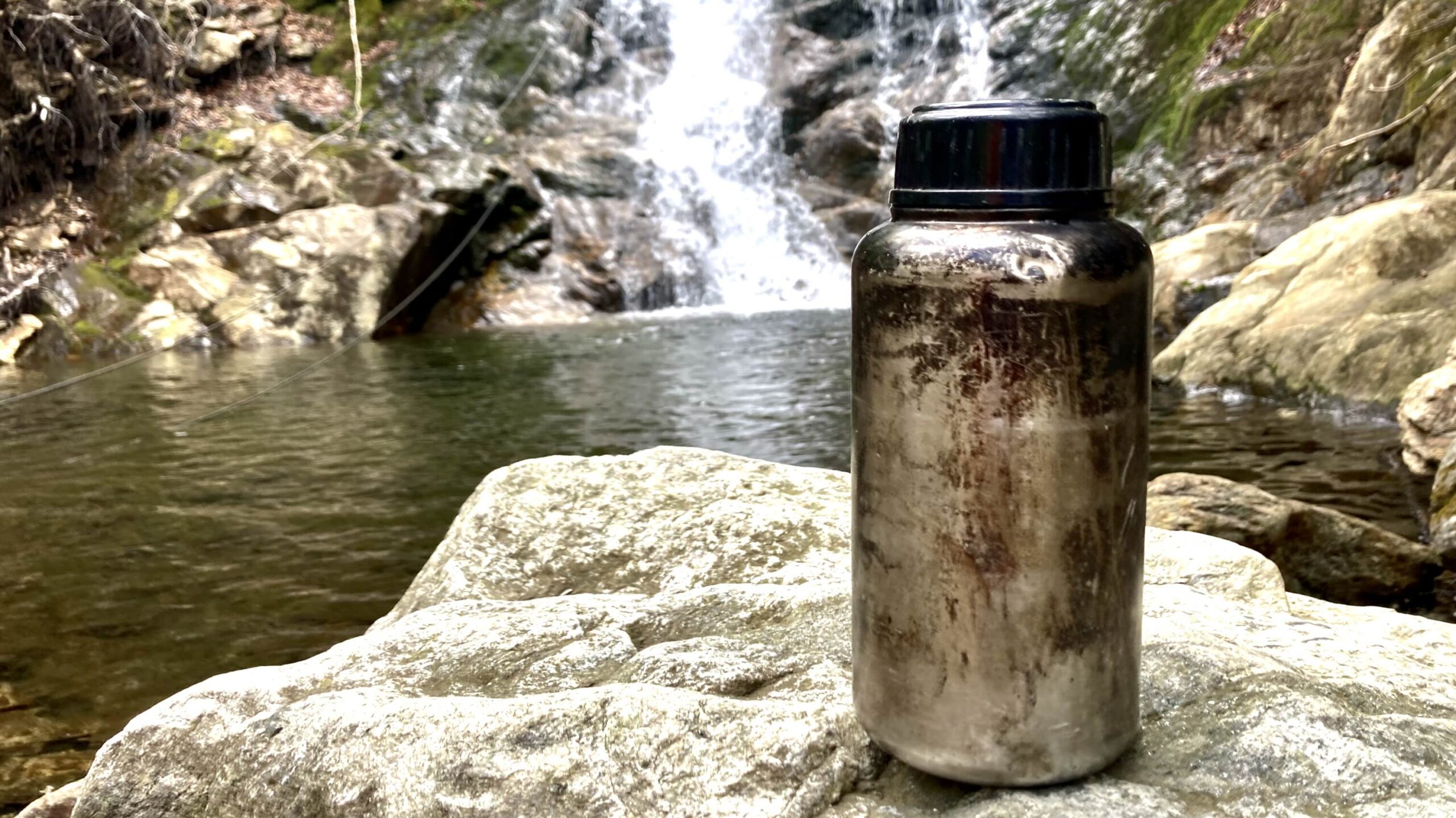It has been quite some time since I have attended a pistol class. I’m not a GM or anything, but I have a decent level of skill with a pistol, and handgun classes just haven’t been a training priority for me over the past few years. This year I ran across the Cognitive Conclave, a pistol class offering something different and I had to do it. This is a detailed, after-action review of that class.
This article contains affiliate links.
Full Disclosure: I paid full tuition to attend this course. I received no incentives, financial or otherwise from any of the instructors, their respective companies, the hosting range, or any other entity for this review.
Cognitive Conclave
Note: since the original article posted, Erick, John, and Lee have done a “Cognitive Conclave Recap” on That Weems Guy Podcast. You can listen to it here.
Most pistol classes are “firing squad training,” that is, standing on a line firing prescribed drills, all weekend. Although the course description was purposefully vague, it promised something different. The description said “Erick Gelhaus, John Hearne, and Lee Weems team up to offer this unique learning opportunity with a heavy focus on the cognitive application of the pistol.” And that’s about all it said. Who wouldn’t attend that class?
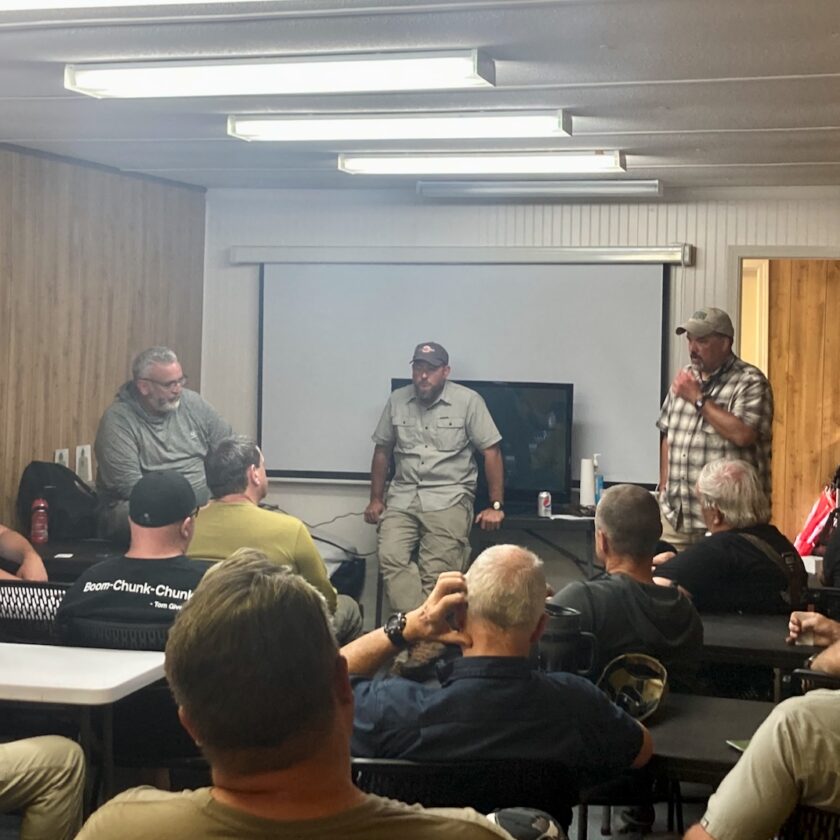
Administrative Details
The course cost was $500. The gear list was pretty light: a pistol, 3-5 magazines, 500 rounds of ammo, and PPE. Lunch was not provided, but was available for sale on Saturday. I shot the class with my Nighthawk Custom 9mm 1911, using S&B 124-grain FMJ. By my count I fired 84 rounds on Saturday and right at 200 rounds on Saturday. Class ran from 0900 – 1700 both days. I didn’t feel like I was short-changed with any training, but still went home with plenty of ammo…which tied in with an underlying theme of the course: we shoot too much at shooting classes. During this class we would look at a lot of targets that we would NOT shoot.
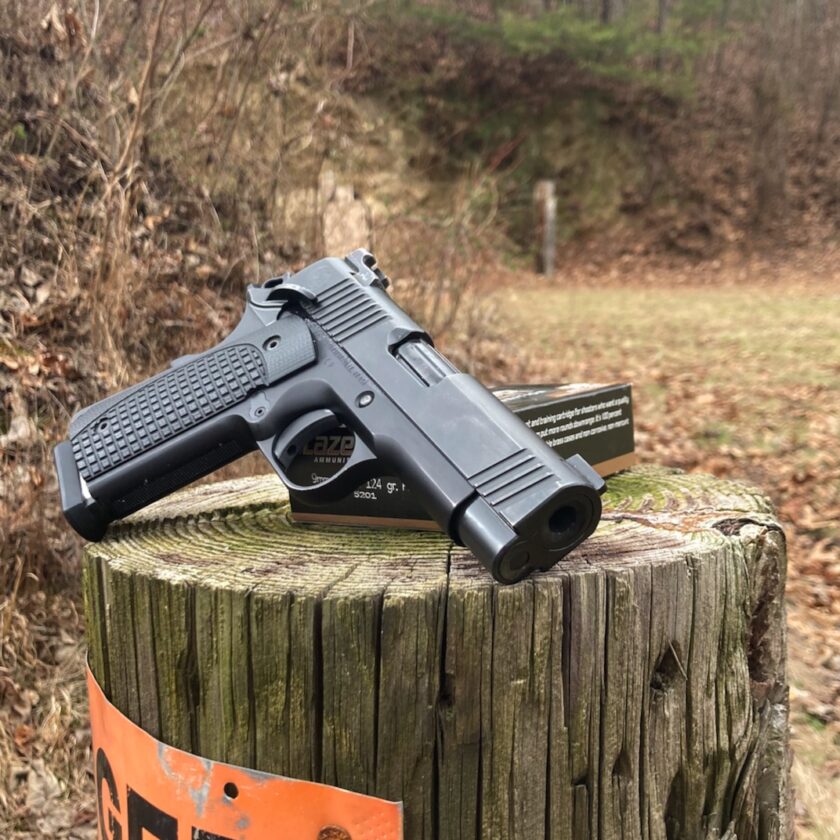
Let’s jump in. I’ll give you an an hour-by-hour replay of the class, then I’ll share some of the lessons I learned from the Cognitive Conclave.
Saturday Part I: Classroom
The Cognitive Conclave began at 9 AM on Saturday morning. All 26 attendees piled into the classroom for the morning session. After administrative details (roll call, waivers, etc.) the class began with a review of the Six Firearms Safety Rules. That’s right: six. You should know the first four. Lee Weems said that Colonel Cooper just didn’t have time to get around to Rules 5 and 6 which are:
- 5. If you drop it, let it go.
- 6. If it’s not time to shoot it or handle it, leave it alone.
With the safety rules thoroughly covered, medical personnel were assigned and the medevac plan was briefed, then dove in!
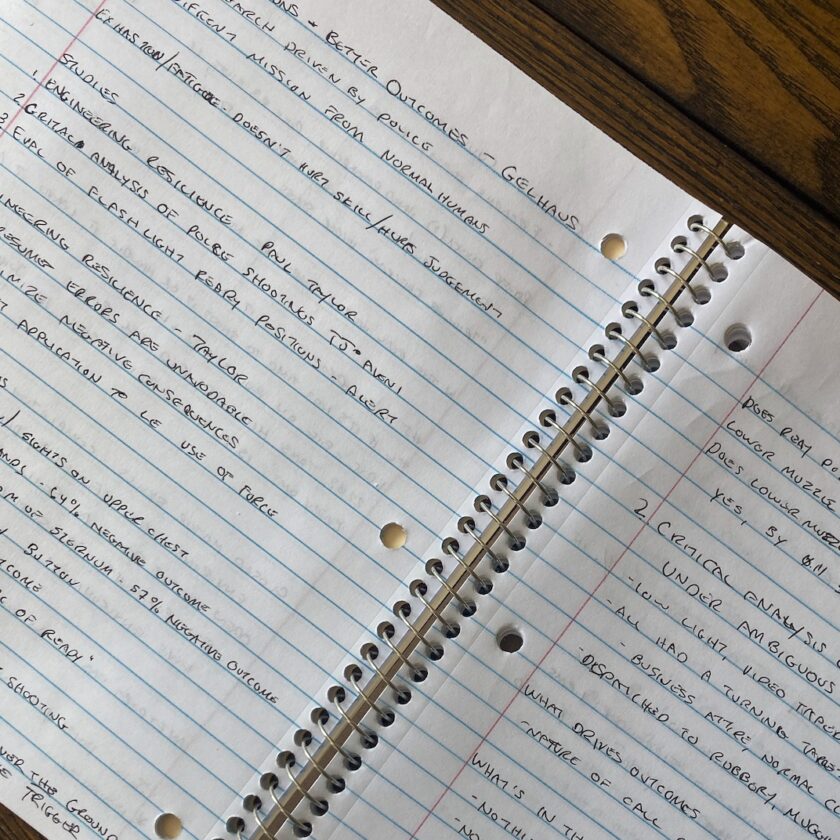
The first portion of class was a talk from Erick Gelhaus on ready positions. This was a truncated version of his Ready Positions and Better Outcomes presentation. This talk basically posits that some ready positions are better than others. The higher the ready position (i.e. aimed in on the chest), the more obscured your view of the hands, and the greater likelihood of a mistake-of-fact shooting. The lower the ready position… Well, you get the idea. You can read a synopsis in Gelhaus’ own words here. We would have the chance to test this later on the range. I’m certainly glossing over this; I have three solid pages of notes from this 90-minute(-ish) lecture.
Classroom & Facility
After the talk we headed down to the “pistol pit.” The class was held at the Red Hill Range in Martin Georgia. It was a fantastic facility, having two discrete ranges, a classroom, and running-water bathrooms. It was also convenient at just over an hour away from the Atlanta airport and the Greenville, SC airport. Doubtlessly this contributed to the surprisingly large (to me) turnout. Two ranges (and three instructors, plus the Magnificent Steve Havey) allowed the class to be broken down into two groups to facilitate more training with very little unnecessary downtime.
Bakersfield Qual
The first shooting exercise was the Bakersfield Qual. Greg Ellifritz describes this course fire, and it’s designer, in detail here and you should definitely read this article. It also covers the appropriate target and scoring. I borrowed the COF and pasted it below which means very little without the scoring system so again, go ready Greg’s article. Here’s the course of fire:
- 2 rounds in 1.5 seconds at 10 feet
- 2 rounds in 2.0 seconds at 20 feet
- 2 reload 2 in 6.0 seconds (8.0 for revolvers) at 30 feet
- 2 rounds in 3.5 seconds at 60 feet
This is a challenging test, especially when fired cold, in front of a bunch of folks you don’t know. I had never previously fired this drill, but I’m very excited to play with and show it to some friends. For a quick, 10-round drill it will teach you some things about your skill level. I fired a 94, without time penalties. Unfortunately I fouled my cover garment on the first stage and had two time penalties there. Still I pulled off a 92 and had the 4th highest score in the class on this drill.
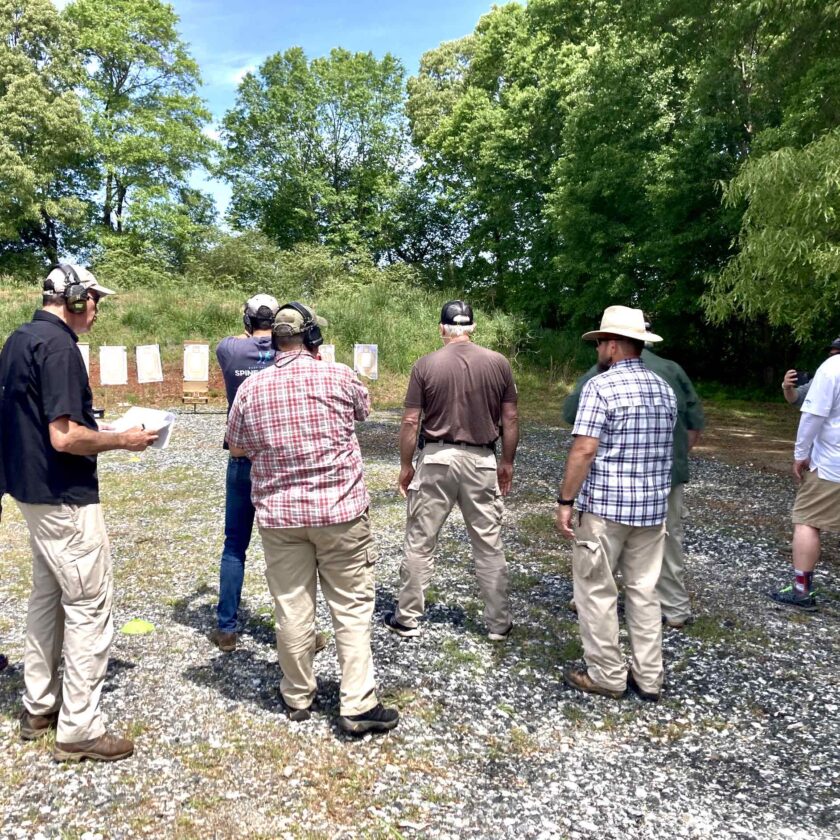
After the Bakersfield Qual we were broken into two relays and sent to lunch. After lunch Relay 1 reported to the pistol pit with Lee Weems.
Saturday Part II: Weems
After lunch we jumped right into the inboard versus outboard manipulations portion of Lee’s class. Lee stated that he’d like to see us using inboard manipulations – that is, rolling the pistol inboard and “slingshotting” from the rear of the slide to clear malfunctions, rather than cupping the hand over the slide. The reasoning behind this was explained. The benefits of this are many and include speed and success rate. The inboard method also places the hands much closer together after racking the slide than the over-the-slide “power stroke” that many of us grew up with.

One of the most gratifying portions of this was Weems’ philosophy of, “it’s OK. Try it this way. If you don’t like it, and want to go back to your way…it’s OK.” So many instructors insist their way is the way. The attitude of “it’s OK” was incredibly refreshing. After some instruction we hopped on the line with our 10 dummy rounds and got to work. We started with some simply “tap, rack, reassess” malfunction clearances. We shot a couple magazines mixed with ammo and dummies. Then Lee began introducing a bit of cognitive load.
The Modified Andy Drill
Next we shot the “Modified Andy Drill.” This drill is Lee’s take on a drill Andy Stanford ran at the Surgical Speed Shooting Summit. This drill is shot on two targets. The first is 3 yards from the shooter. The second target is roughly one yard to the right or left, and three yards further back. Both targets are Weems’ own FPS-1 Target. Here’s the drill:
- Fire three rounds to the closest body,
- Fire three rounds to the closest head,
- Perform a slide-lock reload and step to the right or left (to get yourself in front of the second target),
- Fire three rounds on the body of the second target, then
- Fire three rounds to the second head.
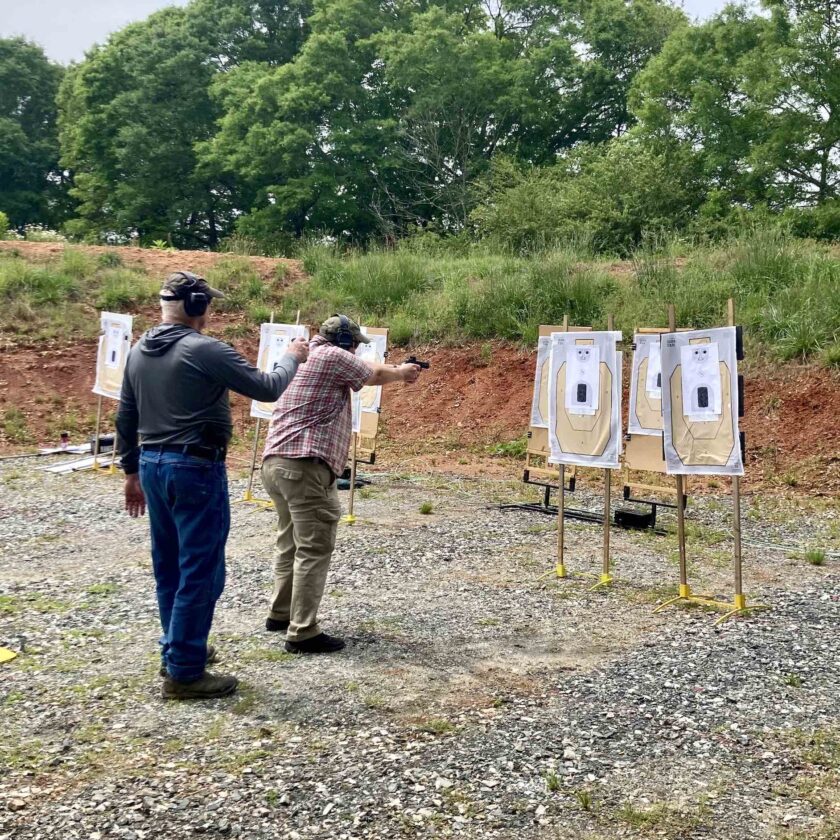
Only clean runs counted. The added complexity was adding in one dummy round – somewhere – into one of the shooter’s two magazines. This seemingly minor modification made the drill quite a bit more challenging. That one dummy had the potential to really interfere with your flow. The second iteration of the Modified Andy was shot backward: starting with headshots on the far target. My first run was shot in 9.32 (clean), and I dropped a headshot on the second run.
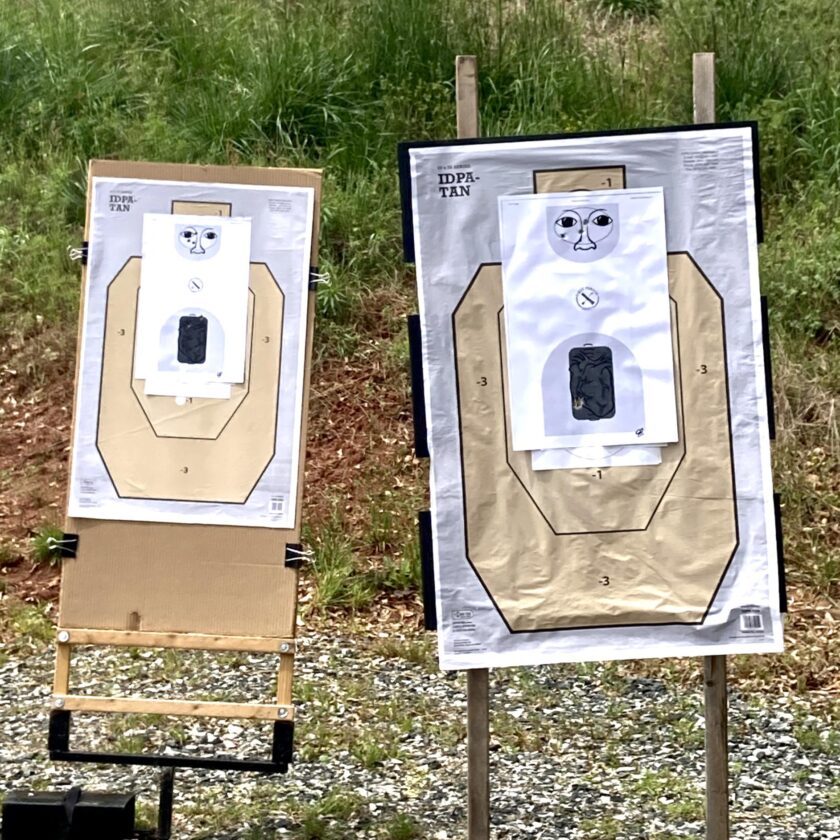
After Lee was finished with us we swapped ranges and went to Gelhaus.
Saturday Part III: Gelhaus
Gelhaus began by having us shoot an array of 6 reduced steel silhouettes as fast as possible, twice. No explanation was given, just, “go as fast as you can.” The timer worked its magic and I had a pretty spectacularly bad first run.
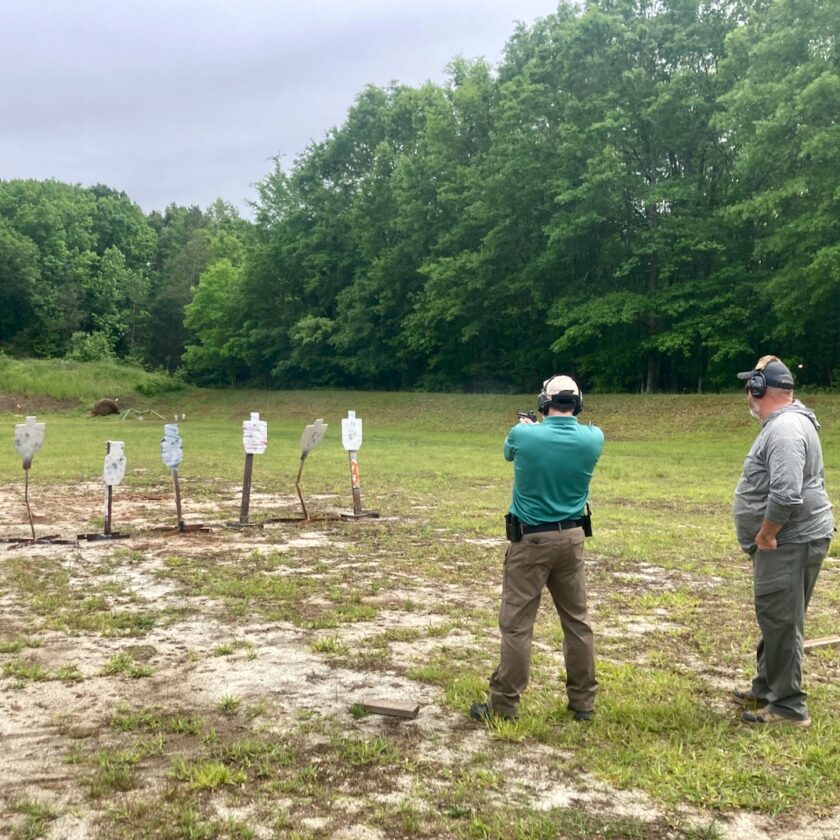
After everyone had done this once we moved over and began a different drill. This on involved turning, No Shoot/Shoot targets. As each target turned we had to make a decision to shoot (or not) as appropriate. This was the first target discrimination training I have really done since doing CQB and IHR training in the military. Though this was much lower round-count than the stuff we’d been doing it was incredibly valuable. Our results may have been influenced by our still being in “go fast” mode after shooting the steel.
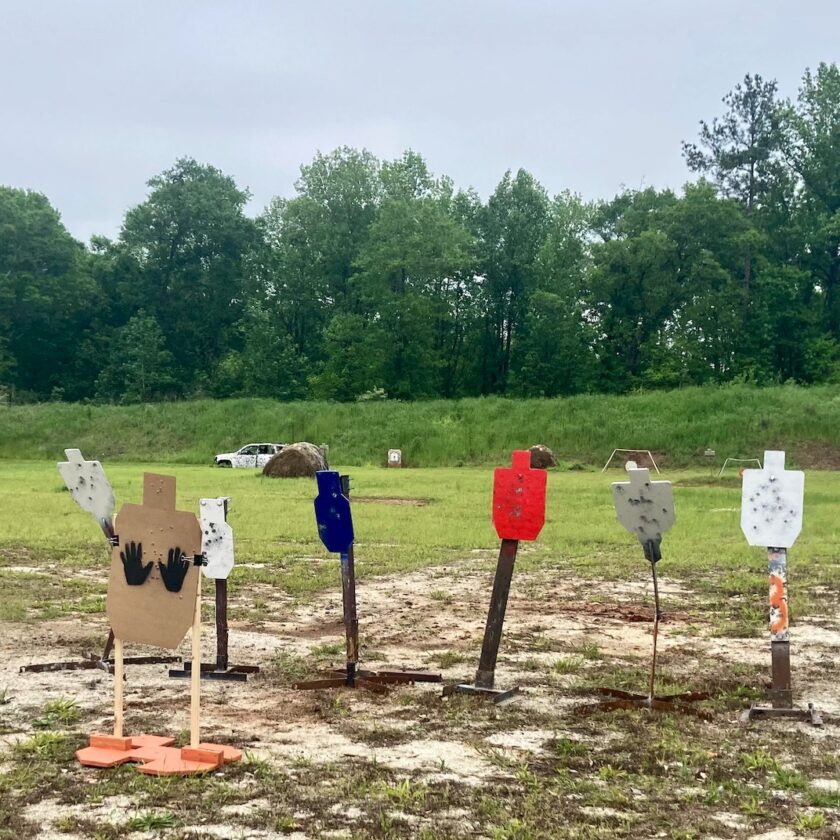
We wrapped up by going back to the steel. We shot on the reduced silhouettes, but with no-shoot targets mixed in. There was a heavy emphasis on Rules #2 and 4, of the Four Firearms Safety Rules. This was practiced by having no-shoot targets in the foreground and background, and mixed in with the target array. This is a huge departure from the standard “make sure you’re shooting into a berm” treatment Rules 2 and 4 normally get.
At this point we broke for the day. A big group of us went to dinner together. I felt pretty honored to be sitting at the same table with these instructors. I was actually close enough to John Hearne to talk to him a bit (and I’ll be honest: I’m a big John Hearne fan so this was super cool). After a big steak and two Sam Adams’ I walked to my hotel and crashed hard.
Sunday Part I: Classroom
Day two of the Cognitive Conclave was grey and rainy but some classroom time was planned anyway so it wasn’t a show-stopper. We began with two abbreviated lectures from John Hearne: “John’s Favorite Study for 2023,” and “Tactical Anatomy.” Again, both of these were really shortened. I’m going to give you the Clif’s notes takeaways from the first: you can be “good enough” at shooting. John says that someone who is roughly a B-Class USPSA shooter is probably good enough to survive a gunfight, and maybe should spend some time learning other things. How good is “good enough?” I’m not going to steal the man’s thunder (or give you his four keys to good training) but he did recommend working toward the recommendations in this blog post by Karl Rehn.
The Tactical Anatomy lecture was equally fascinating. John talked about the differences between psychological and physiological stops. Some criminals are dedicated actors. Sure, some only want to see your gun and will leave as soon as they see it. Some are “dedicated personnel,” however. John brought up another incredibly interesting point: some have been shot before. Pulling your gun on someone who knows what it’s like to get shot may not have the effect you think it will.
The big Tactical Anatomy takeaway is that common A-zones or Down-0 zones are too big. John recommends shooting at a 8.5 x 5.5″ vital zone – a piece of printer paper folded in half (or his 2PT Chest Target) and hung vertically. This replicates the area of the upper chest that contains the great vessels. On a fit male this is (roughly) the area bordered by the suprasternal notch, the xyphoid process, and the nipples. John also highly recommends practicing the failure drill and working the hell out of head shots.
5-Yard Roundup
The rain slacked up just as the classes were concluding. The whole classed moved down to the pistol pit and we shot Justin Dyal’s 5-Yard Roundup. If you aren’t familiar with this drill, it’s pretty simple. All stages are fired at 5 yards on a B-8 Repair Center. All strings are fired in a time limit of 2.5 seconds. Scoring is per the numbers on the target. The stages are:
- From the holster draw and fire a single shot,
- From the low ready, fire four rounds,
- From the low ready fire 3 rounds, strong-hand only, and
- From the low ready fire 2 rounds, weak-hand only
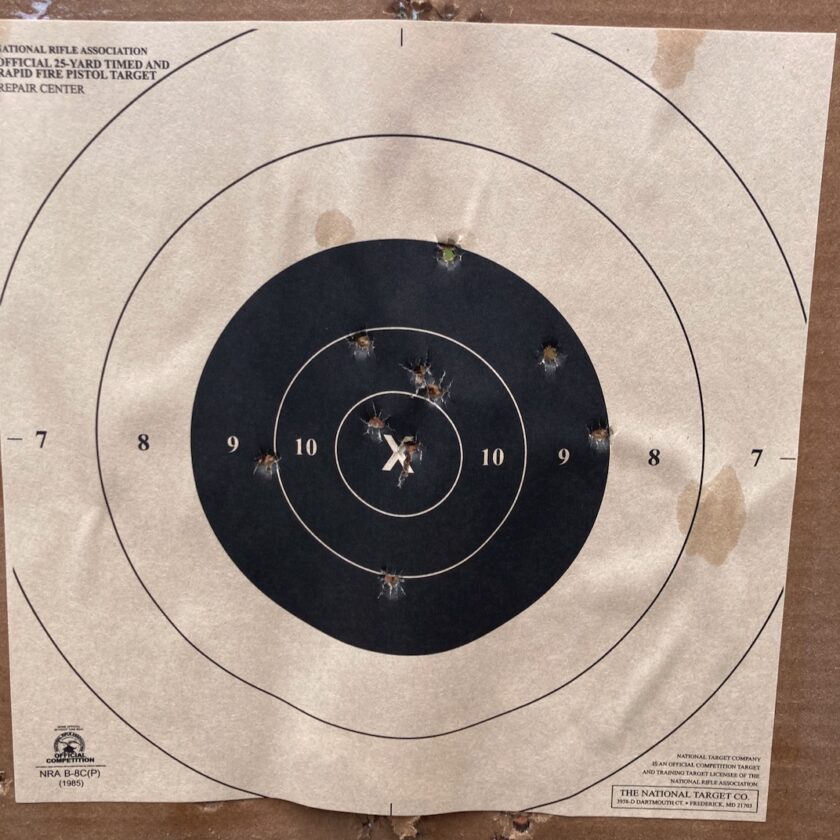
My target (the target shown above) was scored as a 94 on the 5-yard roundup. After this drill we broke for lunch. The relays stayed the same with Relay 1 starting in the pistol pit and Relay 2 going with Gelhaus. The pace on Day 2 would be much faster, and the round-count would be quite a bit higher.
Sunday Part II: Hearne
Returning from lunch we began working with John Hearne. We got on line and began shooting some failure drills. Everyone was easily able to shoot a clean failure drill in a couple seconds – some in considerably less time. These were fired on John’s 2PT chest target and his Angry Face target because, “if you ever have to shoot someone in the head, they’re going to have eyes.” Then things got interesting! John broke out the light boxes, the part I really came for. You’ve probably seen these boxes on Lucky Gunner’s Video, Thinking With a Gun In Your Hand. The lights added cognitive load by making us process information.
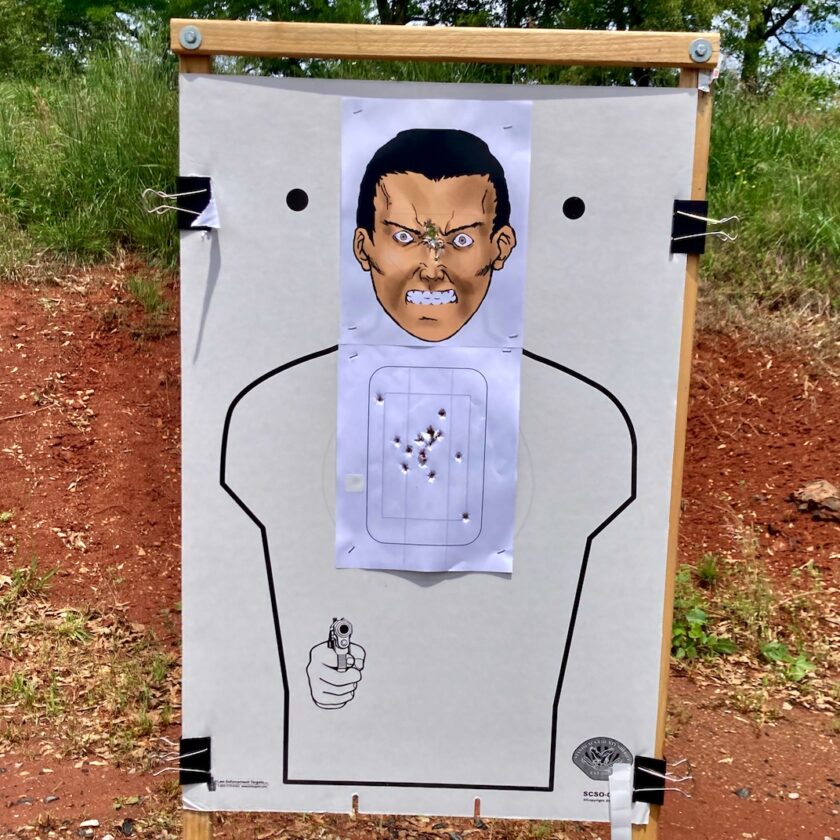
It started like this: we were online in front of our targets. The box would light up. One light meant a headshot, two meant two shots to the body and three shots meant… Three shots meant draw and challenge the target verbally. Interesting twist, right? Oh, and once you’ve challenged the target guess what? The lights might change, requiring shots. The situation in the real would could change, based on stimuli received visually, so why not in training?
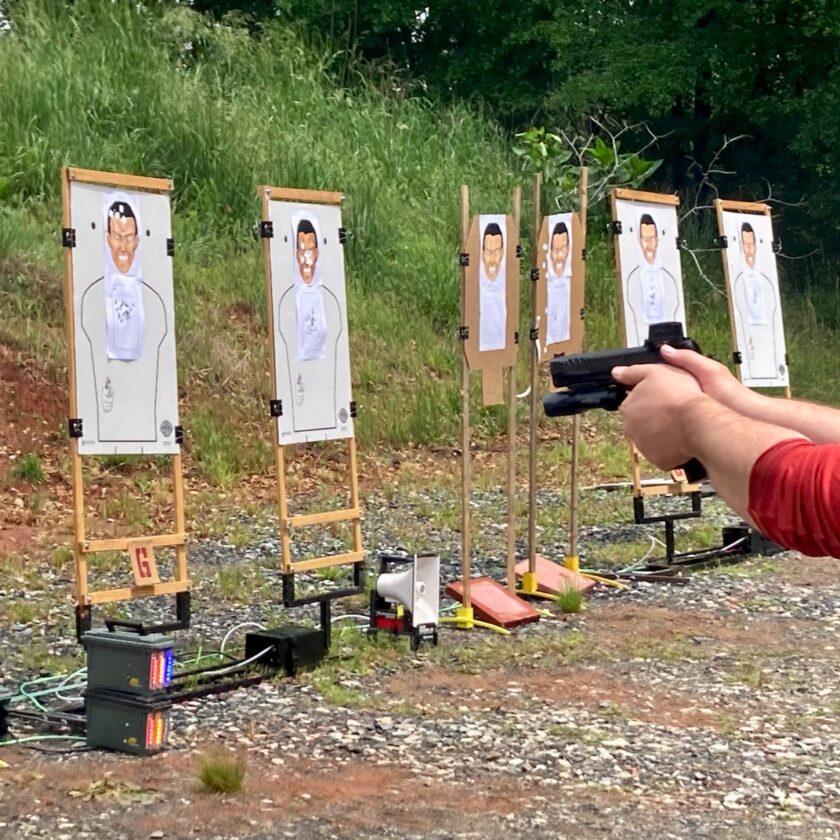
The lightbox setup only got more challenging. John added another box, and we had to make decisions based on additive information from both boxes. One provided the justification to shoot, while the other prescribed the drill. The boxes got moved around requiring REAL scanning/assessing. Eventually there were (I think) four boxes on the field.
Saturday Part III: Gelhaus
Then the relays swapped. We went back to Gelhaus for an amped up version of yesterday. Again, there were some judgmental drills. The first was the “blue tape” drill. This involved the shooter facing uprange with three targets downrange. Someone would doctor ONE of the targets. As many as three pieces of blue tape were placed on the target. One piece meant fire a head shot, two meant two body shots, and three meant fire a failure drill. This drill was a change of pace from Hearne’s fast-moving station, but it was still very valuable.
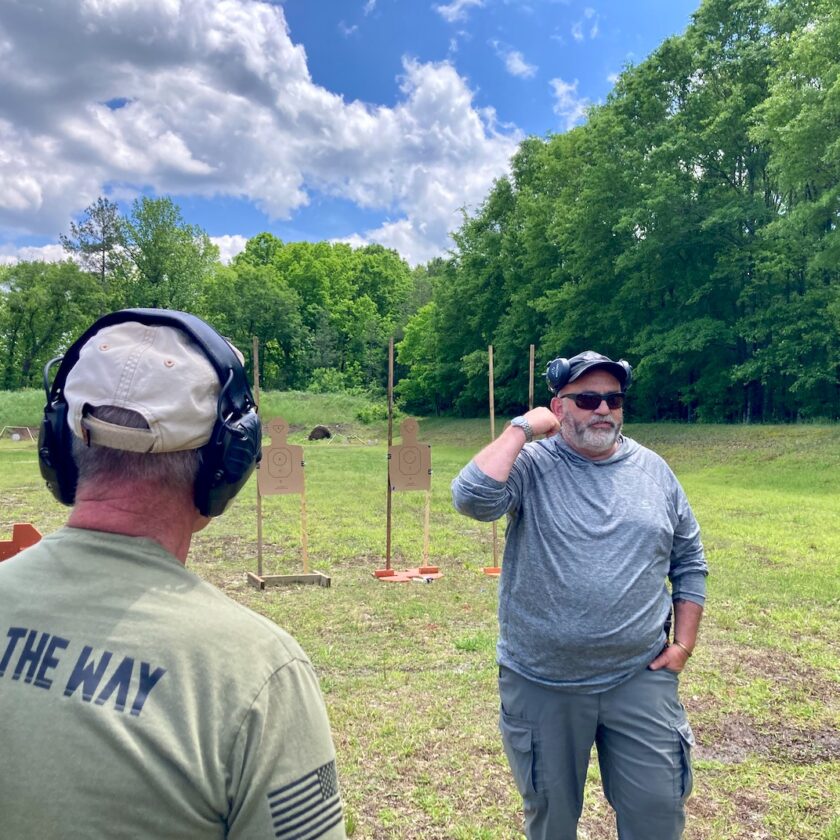
First, it was judgmental, No Shoot/Shoot training. Second, it is a very accessible drill. It doesn’t require turning targets, VR simulators, or any other expensive equipment. It’s a simple way to add cognitive training into your range sessions. I will be doing this at the range with my buddies later this week.
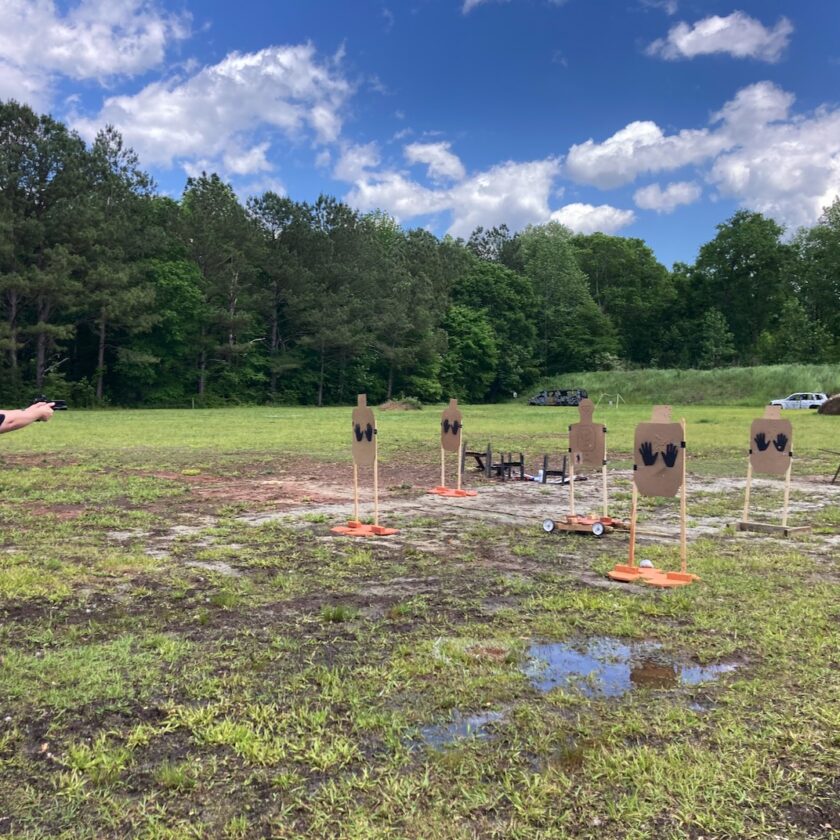
Next, we dug deep into Rule 4 training: being aware of your target, and its background and foreground. This involved shooting a lateral mover in a huge array of no-shoots. This required some pretty nimble gun handling to avoid muzzling the no-shoot targets. This certainly added texture to the “never cover anything” and “be aware of your target” rules. It also allowed us to shoot in an environment that felt complex but is probably very simplistic compared to a busy city street or shopping mall during a shooting. Wrapping up this station we had a chance to shoot the Tueller drill against a mover running toward us – something you almost never get to do.
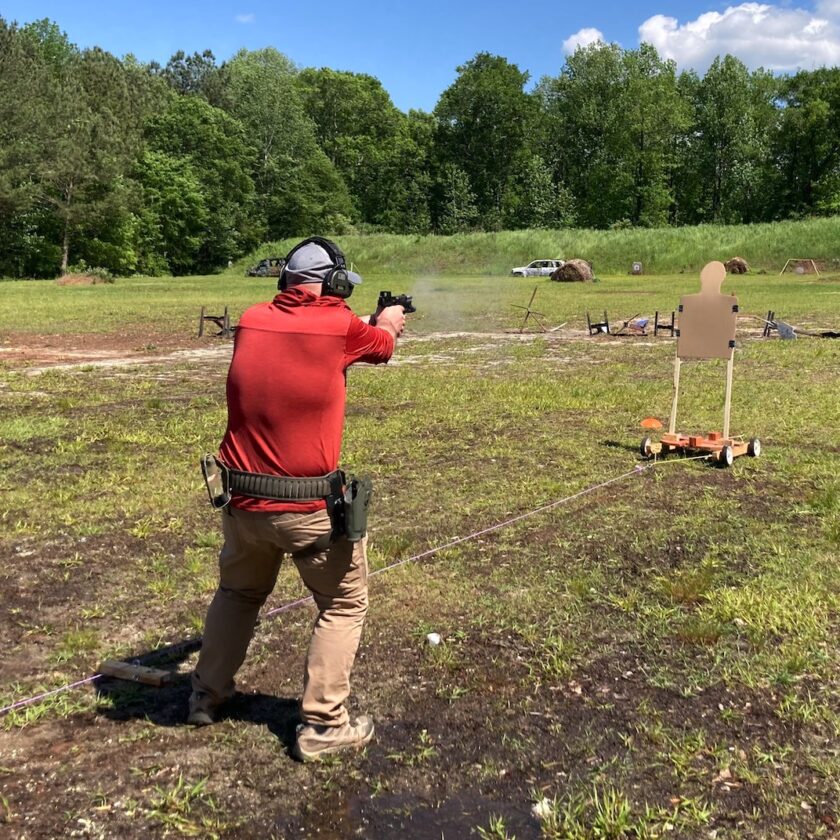
Saturday Part IV: Hearne
At the end of the day we went back to Hearne for a final period of instruction. This was a condensed version of his Tactical Anatomy practical. This part went pretty rapidly as time was running out, but it was one of the most interesting portions of the course.
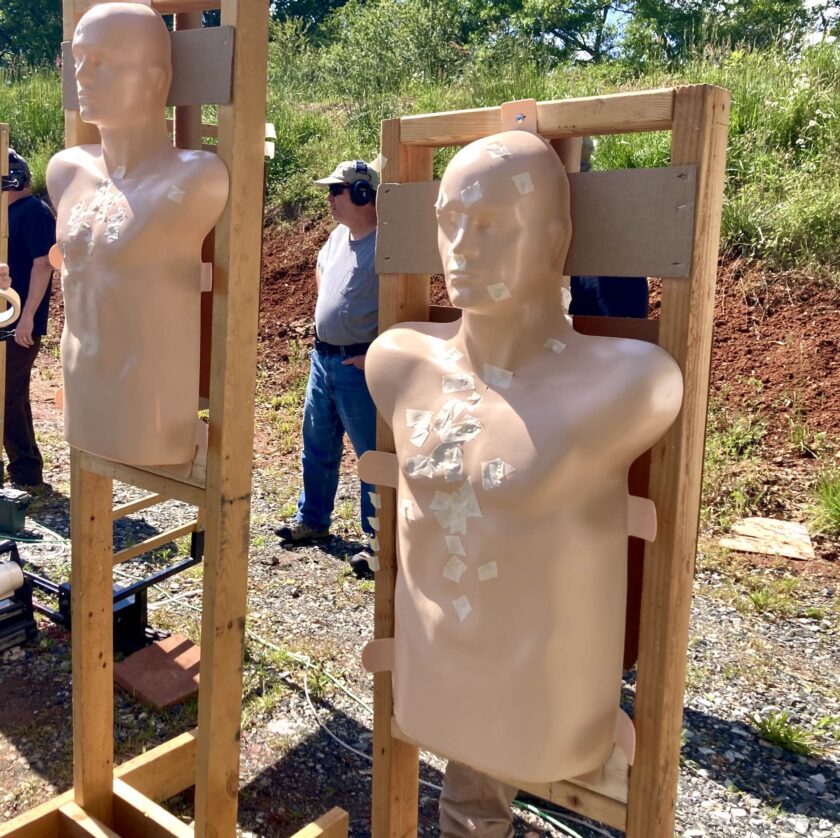
First, we shot 3D targets. The opportunity to do this is incredibly rare, and I expect I will be buying some 3D targets soon. This is a completely different experience to shooting flat, paper targets with squares and circles. As I learned by shooting clothed targets a few weeks ago, there is no clearly-defined A-zone.
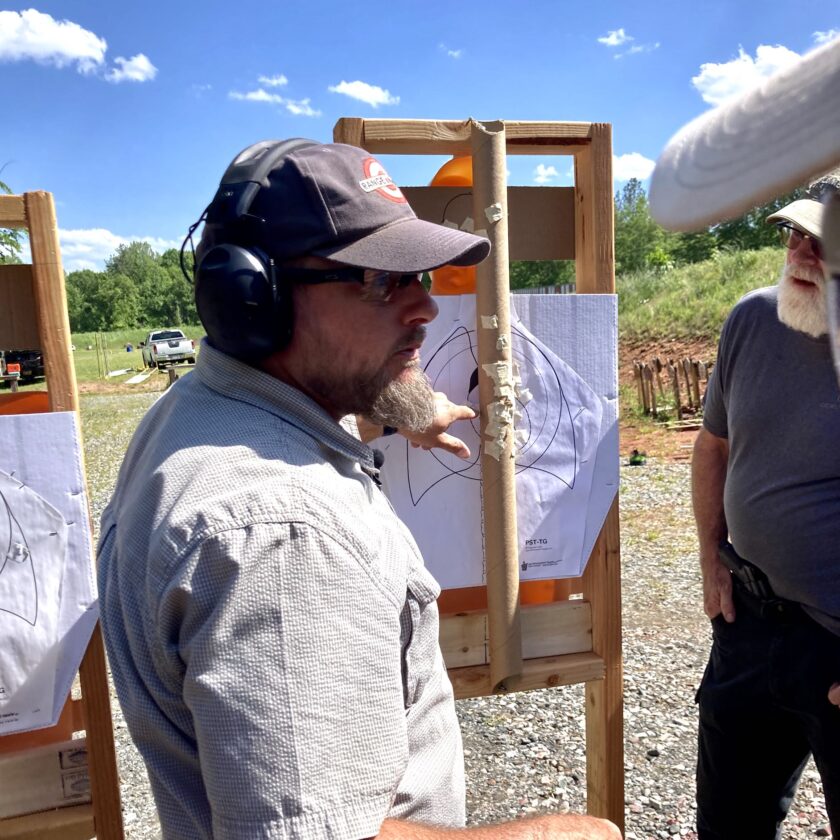
Hearne also made this a bit more interesting and informative by adding anatomic reference points behind the the 3D target. Paper depicting the heart, great vessels, spine, and lungs was behind the 3D target, along with a cardboard tube representing the spinal column. This was tremendously valuable in letting the shooter understand not only the superficial location of hits, but what they mean in a 3D human body. Our goal in a defensive shooting is to stop the threat as quickly and with as possible, and understanding anatomy is critical to achieving that goal.
Sunday Part V: Shoot-Off and Wrap-Up
The day concluded with a man-on-man steel shoot-off. Since John Hearne ran this portion it was fired using his light system. Two light boxes were put out, about five yards in front of the shooters. Five yards further downrange was an array of steel targets in various colors. When the lights… Oh, come on – you didn’t think I was going to give this part away, did you?
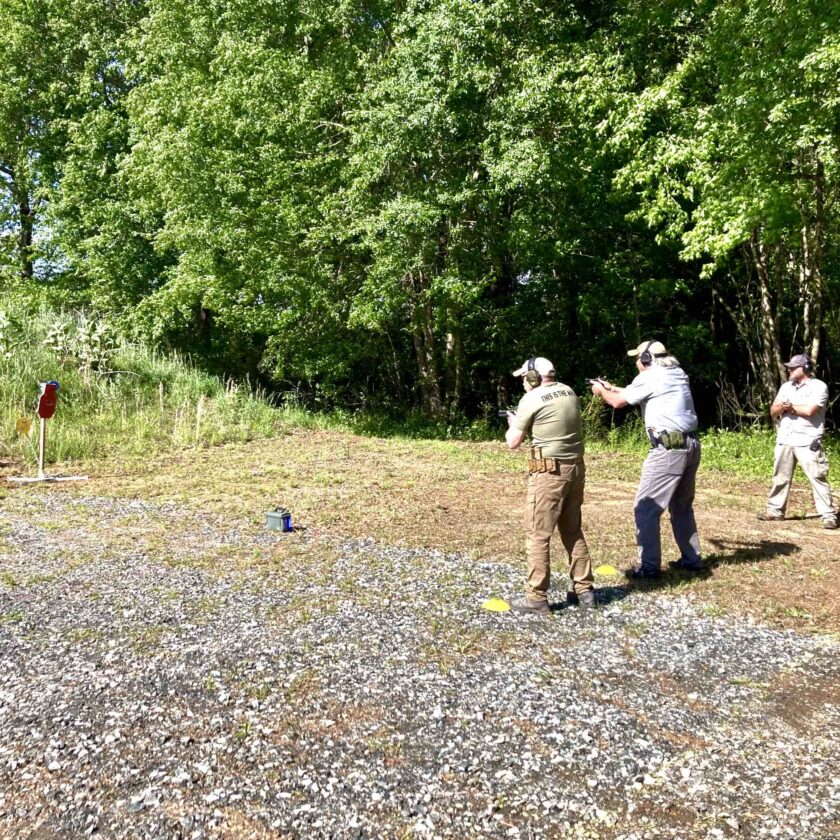
The shoot-off was challenging. The class was full of outstanding shooters. I was eliminated in the first round by a dude named Dan who shot at the top of the class all weekend. It sucked to get eliminated right away, but there was no shame all in being sat down by Dan.
After the shoot-off we retired to the classroom. Awards were given for high shooters on the Bakersfield qual and the 5-Yard Roundup. Feedback was solicited, “thank you’s” were said, phone numbers were exchanged, and the class was dismissed.
Cognitive Conclave: Lessons Learned
So what did I learn from the Cognitive Conclave? Let’s take a look at some things I took away from this class.
Ready Positions
Ready positions are important. The ready position you choose can greatly increase or decrease the likelihood of a mistake-of-fact. If there is any way to avoid being in a shooting, I will take it. If there is a way to avoid shooting a “no shoot,” I will absolutely listen. The optimal ready positions seem to be a low-ready with the muzzle just between the target’s feet, or a high compressed ready with the muzzle pointed just above the target’s head. Basically, these positions provide the least-obstructed view of the target’s hands, giving you the most discretion possible. They do add maybe a 10th of a second to your first shot, but as Erick pointed out, if your shooting comes down to 1/10th of a second you did a LOT of stuff wrong leading up.
Cognitive Load
Adding cognitive load will teach you a lot. It will teach you how quickly the wheels can fall off without automaticity. Automaticity will allow you to continue to run the gun at a high level while thinking about everything else. You can process the situation, give verbal commands, seek cover…all while shooting accurately, clearing malfunctions, and reloading. But only if those skills are automated. As Lee said, “an expert has an automatic use of the tool.” Cognitive load can also give you a glimpse into the chaos of a real-life, life-or-death situation.
Inboard Manipulations
I learned that I, apparently, already use inboard manipulations when clearing malfunctions. When Lee taught the class I started wondering, “how do I do it?” That sounds funny, but I’ve just been doing them for so long I hadn’t really examined my technique lately. I can tell you exactly how I perform any of the various reloads, but for some reason had no clue how I cleared a simple “tap-rack-reassess” malfunction. Once we got on the line and started doing it I realized that inboard clearances were just happening automatically. I’m glad, because after Lee’s explanation of the benefits of inboard manipulations, I’m sold.
Being Shot by Cops
Your behavior influences your likelihood of being shot by law enforcement. If you are involved in a shooting, law enforcement WILL respond. You don’t have a halo over your head, so to them you’re just a guy with a gun. The studies John Hearne presented demonstrate that you can do things to make cops less likely to shoot you. The best case scenario is to raise your arms straight up, high in the sky. Open your hands, extend your fingers, and turn your palms so they are visible. Finally, be compliant. I don’t want to die at the hands of the police any more than I want to die at the hands of a bad guy. This is important information that might save your life!
More Training
Another big takeaway is that I need more training with this crew. This was my first Rangemaster-heavy event, and I will definitely be back. I want to take more classes from these instructors specifically, and from Rangemaster-affiliated personnel generally. I have already signed up for the 5-day Protective Pistolcraft Instructor Development course in October, with Tom Givens, Tiffany Johnson, and John Hearne. There was a heavy Gunsite presence, as well. Going to Gunsite 250 is my main training goal for 2024.
Instructorship
I was a full-time, special operations instructor for four years and 10 months. After that I made my living as an instructor, selling my own specialty courses to the military and intelligence communities. I write about instructorship here pretty regularly and needless to say, I deeply appreciate some high-quality instruction. All of the instructor staff – Erick Gelhaus, John Hearne, Lee Weems, and Steve Havey – were the epitome of professional instructors.
Everything ran on time. Instructors were polite but firm when necessary. Training aids, targets, etc. were ready to go. Class started promptly at the appointed times, and started back up on time after breaks. Instructions were clear, expectations were challenging but realistic. In one specific example, I expected to get some shit for bringing a 1911 to a modern pistol class. But I didn’t. No one was criticized for their choice of gun, holster, caliber, or anything else. Profanity (don’t get me wrong, I love some well-placed profanity) wasn’t heard at all the first day from the instructors. When I did notice on the second day it was appropriate and in the context and not gratuitous. The instructors were ridiculously knowledgeable, and always approachable.
In short, the cadre was exceptionally professional. This class was a huge breath of fresh air after a lot of the public safety training I’ve done in the past couple of years. So, a personal “thank you” to all of them for that.
The Bottom Line
I don’t know if the Cognitive Conclave is coming back or if it’s a one-off. If you get the chance to take it, TAKE IT! There are very few opportunities to practice many of the skills available in this class. Don’t miss the chance.





